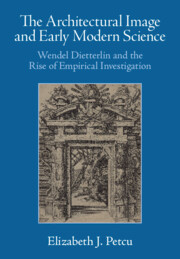 The Architectural Image and Early Modern Science
The Architectural Image and Early Modern Science Published online by Cambridge University Press: 29 November 2024
Dietterlin’s Architectura prints and the processes he used to form them engaged with sixteenth-century Central Europe’s robust culture of alchemy to transform the architectural image into a context of scientific inquiry. Formal and iconographic analyses of architectural etchings by Dietterlin, Wenzel Jamnitzer, and Hans Vredeman de Vries, in conversation with texts by alchemists Agrippa of Nettesheim and Paracelsus, reveal how architectural image-makers used etching’s mercurial, shapeshifting forms and the protean materiality of ornament not only to picture but also to activate alchemical theories and principles of empirical investigation. Dietterlin’s Architectura prints channelled etching’s alchemical dimensions, comparing the material and chemical transformations involved in architectural etching with the processes of transmutation studied in contemporary alchemical research. As is evident from the alchemical imagery that Dietterlin’s Architectura contributed to the court art of Holy Roman Emperor Rudolf II, the Architectura established architectural images as contexts of alchemical thinking in the years around 1600. In sum, the transformative structures of Dietterlin’s architectural etchings allowed architectural prints to become fora for natural philosophical inquiry.
To save this book to your Kindle, first ensure [email protected] is added to your Approved Personal Document E-mail List under your Personal Document Settings on the Manage Your Content and Devices page of your Amazon account. Then enter the ‘name’ part of your Kindle email address below. Find out more about saving to your Kindle.
Note you can select to save to either the @free.kindle.com or @kindle.com variations. ‘@free.kindle.com’ emails are free but can only be saved to your device when it is connected to wi-fi. ‘@kindle.com’ emails can be delivered even when you are not connected to wi-fi, but note that service fees apply.
Find out more about the Kindle Personal Document Service.
To save content items to your account, please confirm that you agree to abide by our usage policies. If this is the first time you use this feature, you will be asked to authorise Cambridge Core to connect with your account. Find out more about saving content to Dropbox.
To save content items to your account, please confirm that you agree to abide by our usage policies. If this is the first time you use this feature, you will be asked to authorise Cambridge Core to connect with your account. Find out more about saving content to Google Drive.